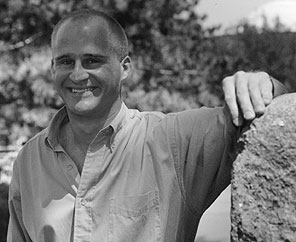 |
|
||
|
Vol. III No. 36 · Week of 23 June 2000 |
|||
B.U. Bridge is published by the Boston University Office of University Relations.
Abduction
from the seraglio
Student's
prize-winning study of bats has implications for evolutionary biology
By Eric McHenry
He’s neither a fielder of foul balls for the Red Sox nor an apprentice superhero, but Jay Storz answers to the name “Bat Boy” all the same.
|
|
|
| Jay Storz Photo by Kalman Zabarsky | |
As a Ph.D. candidate in ecology, behavior, and evolution, he’s won the moniker with feats of undeniable daring — journeying to the jungles of western and southern India, climbing bamboo ladders, and catching scads of short-nosed fruit bats with a big, telescoping butterfly net.
The bats are extraordinarily polygamous, with a relative handful of adult males monopolizing mating opportunities. Storz (GRS’00) is interested in the effect this has on the “genetic drift” of the species — the process of random change in its gene pool. He shared the results of his studies at the 80th annual meeting of the American Society of Mammalogists, held June 17–21 at the University of New Hampshire in Durham.
“This particular fruit bat is interesting because it forms these enormous harems,” says Storz, who gave one of the conference’s plenary lectures as winner of the 1999 Shadle Fellowship Award in Mammalogy. The society confers the fellowship annually upon the American graduate student with the most outstanding research project. “So in terms of skewed reproductive success, this species is at the far end of the spectrum. That’s why it was a good subject for this research project.
“In addition to simply telling us more about this particular species,” he adds, “the project has significance to evolutionary biology in general, because the same principles apply to any animal species with an extreme mating system or any kind of demographic feature that results in reproductive skew.”
The short-nosed fruit bat is also known as the “tent-making bat,” and with good reason. An enterprising adult male will burrow into a pendulous cluster of fruit at the top of a palm tree and begin chewing off stems, creating a bell-shaped hollow where his harem can roost. This “tent” has a single exit portal, which makes it possible for him to guard up to 40 females, and also makes it possible for scientists like Storz to net specimens.
“Basically, I would just seal up that hole with the hoop net, and that would trigger a flight response — they’d try to escape, and would just funnel right into the net,” says Storz.
In a given breeding season, a female bat gives birth to a single pup, which clings to her at all times during its suckling stage. So each netful was a complete package of sorts, containing one readily identifiable adult male and many mother-infant pairs.
Storz would then return to his field camp, where he and his colleague, Dr. Hari Bhat of the National Institute of Virology in Pune, India, would pull on thick leather gloves and take tissue biopsies from the wing membranes of the captured bats. Before releasing them, the scientists would fit each bat with a small necklace. “That allowed us to identify individuals when we re-captured them in the subsequent breeding period,” says Storz, who made three four-month trips to India while conducting his research. “So we were able to track the movements of all these individually marked animals.”
Analyzing the bats’ DNA, Storz and Bhat concluded that the reproductive advantage enjoyed by a small percentage of the adult male population was strongly influencing the genetic drift. The DNA of these dominant bats was determining the genetic character of entire generations. However, the effect was not quite as pronounced, Storz says, “as one might expect.” Competition for females is intense, he explains, because “the reproductive stakes are so high,” and even the most energetic males can only defend a harem for one or two breeding periods before being deposed. This means that the adult male population is much more broadly represented in the gene pool as a whole than it is in any single generation.
“It’s one of the first field studies that has a large database of DNA on a wild animal,” says Thomas Kunz, CAS professor of biology and director of the Center for Ecology and Conservation Biology. “The sample size just dwarfs many other studies. I think he’s analyzed about 700 animals. And any study one does is more convincing with a large, versus a small, sample size.
“This kind of data,” adds Kunz, who is also president-elect of the American Society of Mammalogists, “can be used to estimate what is called effective population size — how big a population has to be in order to maintain its genetic diversity. So Jay has established a model for people who study the effects of forest fragmentation on populations. It has implications for the study of all sorts of species — bats, mammals, and other critters as well.”
Conducting research in the most remote parts of India, Storz says, was an education in more than one respect. For weeks at a time, he and Bhat stayed in tiny communities whose language existed only in spoken form, and whose youngest denizens had never seen a white person.
“In one particularly isolated village,” he says, “some of the little kids were asking Hari if I had a tail. Apparently, there’s some myth about white-faced people being monkeys in disguise.”
![]()
23
June 2000
Boston University
Office of University Relations
